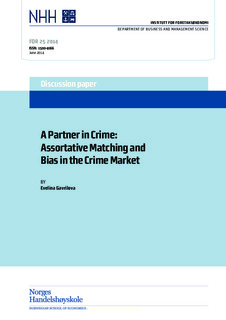| dc.description.abstract | I identify a discriminatory bias in partnership formation within the property crime mar-
ket in the United States. Theoretically, the prisoner's dilemma creates an incentive for a
criminal to form a partnership with a counterpart with the same probability of success, re-
sulting in an equilibrium pattern of positive assortative matching. Using individual matched
report-arrest data from the National Incident Based Reporting System and a novel empiri-
cal strategy, I pinpoint matches where the underlying probability of success of two partners
differ. This difference in probability is correlated with observable characteristics, which
could be evidence for discrimination and search frictions. I find patterns consistent with
discrimination in male-female partnerships and patterns consistent with search frictions in
black-white matches. In particular, females in a male-female partnership are more likely to
evade law-enforcement than males, even though on average males are more successful as a
group. This results is robust to controlling for the criminal earnings, individual criminal
offenses and market characteristics. Furthermore, these patterns are found also in criminal
groups of a size bigger than 2. The result could be either due to pre-crime marital matching
or discrimination. | nb_NO |
